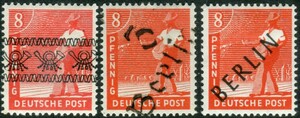1948 CURRENCY REFORM

In the immediate aftermath of the war, old RM currency continued to be used, except in the French Zone and French Saarland where the French Franc became the official currency. Under the III Reich, money was relatively plentiful, but actual goods and housing much less so, because prices were controlled and supplies of food and goods were rationed. This situation continued in 1945 and in the difficult times of basic recovery, barter and black market formed a substantial part of the economy. There was a fear that rapid inflation would break out, as happened in 1923. However, the financial offices of the three "Mark" Zones could not agree a plan to equalise supplies and spending power. In particular, the Soviet Zone administrators had a fixed idea about state control under heavy Russian influence.
In 1946 a standard stamp design was printed in Berlin and intended for national distribution. The French had already issued stamps for their own Zone, so did not sell the Berlin national stamps, though these did have postal validity in the French Zone for a time. Otherwise the RM banknote and the equivalent postage stamps (1947 Numeral design, then 1947 Workers design) moved freely within the American, British and Russian Zones.
Economic changes then hardened the differences between the western sectors and the Russian Zone. The Marshall Plan brought economic growth to the Western sectors, while in the East war reparations plus their rigid state economic planning resulted in a slower recovery. On 18th June 1948 the British and American rulers introduced a new currency, the Deutsche Mark, for their zones (initially excluding Berlin). Amounts needed for payment of wages and rents were exchanged at 10RM = 1 DM. This rate also applied to one half of private savings but the other half was frozen. These saving balances or other larger amounts were subsequently converted at 15RM = 1DM. In addition, to help with the uncertainties of transfer, every person received one-off gift of 40DM and later another 20DM.
This left a pool of RM in the West which could not easily and quickly be converted officially at an acceptable rate, and some of it flooded to the Soviet Zone. The rulers there were forced to "reform" their currency too (24th June) but the two currencies soon became very unequal in unofficial exchange.
To ensure the old national Numeral and Worker stamps were only used within each economic bloc, in the British and American Zones the posthorn overprints were used as a control, while in the East the Bezirk overprints were applied to existing stamp stocks by local towns and districts.
Ludwig Erhard, Minister of Economic Affairs of the Br-Am Zone and then the newly formed West Germany (May 1949), favoured a free market economy and managed to relax financial controls. This led to a boom in supply of goods but at higher prices, not always matched by wage increases. The massive injection of Marshall Plan aid regenerated industry and (at that time) low wages by international standards resulted in a boom for exports and continued growth of West Germany.
The rapid economic fissure of the 1948 currency reform produced the posthorn overprints used in the British & American Zones. In the rush to produce enough for postal needs, and to distribute them quickly, various printers were used. Each OPD-Bezirk (regional postal administration) arranged the overprinting with private firms within their area of jurisdiction. German printing standards were sometimes forgotten : errors of double or badly misplaced posthorn overprints occurred, striking items for philatelic display.
The Soviet Zone also quickly introduced their new currency in July 1948 to discourage black market trading, and the Western sectors of Berlin were blockaded for that reason. The East Germany Mark was in use in West Berlin for a short time, with the former General Zone "Worker" stamps, along with Russian Zone stamps which also remained valid until 21st March 1949. In view of widespread speculation of the "Worker" stamps and to prevent them being used in the western sectors, existing Post Office stocks in West Berlin were overpinted "BERLIN" in black (for sale in East German Marks), and unoverprinted "Worker" stamps in private hands could only be used up to 19 September 1948. The West German currency was adopted in 1949, which gave rise to a new series of "BERLIN" overprints, this time in red, to indicate the new currency.
The corresponding Bezirk overprints in the East are less well known in the UK and listed only in Michel, not Gibbons. Ten Bezirks (regions of the Soviet Zone) applied the overprints :
3 Berlin
14 Dresden
16 Erfurt
20 Halle
27 Leipzig
29 Magdeburg
36 Potsdam
37 Schwerin
38 Stettin
41 Zwickau
These contained 1000+ postal districts, each of which produced handstamps for local use on remaining Numeral and Worker stamps. Small numbers of the Dove stamps, UPU and Leipizig Fair and Hannover Fair issues, where available, also are found with these overprints from certain districts A collection just of these issues could become several volumes.
Some collectors think of 1945 as a good ending point for their German collection. But the 1948 currency reform was a cataclysmic event in modern German history. The resulting stamp overprints and complexities of permitted use on cover provide a fascinating experience in technical philatelic study and in political postal history.
John Barefoot
- Published
- 18/09/22 11:32:00 AM
